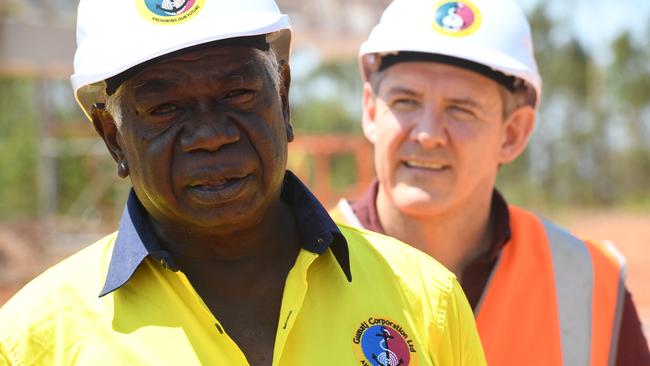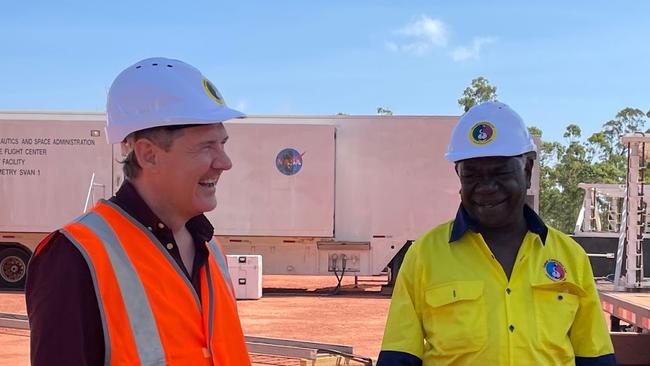Yolngu stories of the stars to be explored at space centre as Chief Minister announces extra $5m investment
After significant investment from the private and public sector the Yolngu stories, be explored with modern science.
Northern Territory
Don't miss out on the headlines from Northern Territory. Followed categories will be added to My News.
UPDATE: THE stories of the stars have been told for generations in East Arnhem Land but after significant investment from the private and public sector the Yolngu stories will be explored with modern science.
Chief Minister Michael Gunner believes the Arnhem Space Centre will inspire generations of Territorians to seek out, learn and understand the universe above.
After visiting the site, located just outside Nhulunbuy, on Thursday Mr Gunner announced a further $5m investment in the Arnhem Space Centre, where Yolngu people, Equatorial Launch Australia (ELA) and NASA have been working together to construct the Territory’s first space port.
“The Gumatj are intimate with the universe above. It is not surprising to me that one of Australia’s first commercial spaceports is under way here, on Yolngu land, home of the planet’s original astronomers,” Mr Gunner said.
Gumatj Corporation chairman Djawa Yunupingu said the stars were the stories of his ancestors.
“We don’t go in the ground when we leave this place, we go up there to look down on this place,” Mr Yunupingu said.
“This is about our stories and their stories and learning together. The space centre is important for my people because when the mine leaves we want jobs here, we want to stay on our Country. This is a chance to do that and do it right this time.”

For the Gumatj Corporation, the Arnhem Space Centre is an opportunity to teach people about Yolngu culture, something that was predicted by Elders long before NASA was ever talked about.
Mr Yunupingu said his father painted astronauts coming to Yolngu land back in the 1960s and the artwork was waiting to be displayed at the culture centre just a few kilometres from the new space centre.
ELA plans to include a visitors centre where the history of the stars can be displayed alongside new knowledge.
ELA chief executive Carley Scott said this was a step towards a bright future for the people in Nhulunbuy, East Arnhem Land, the Northern Territory and Australia.
“This is an exciting and significant time, the project is a drawcard for the region and will bring not just employment but education and tourism as well,” Ms Scott said.
“As part of NASA’s education program, we will be seeing American space agency engineers and scientists mingle with local Northern Territory children, showing them ways to chase their dreams and reach for the stars.”
The Australian space launch market has an estimated value of $US930m over the next decade, which Mr Gunner said the Northern Territory was well placed to capitalise on.
UPDATE: CHIEF Minister Michael Gunner has announced a further $5m to support Equatorial Launch Australia further develop the Arnhem Space Centre.
The announcement comes after Gunner visited the site this morning to meet with ELA and NASA representatives.
“The investment from the NT government and local investors will continue to support local site works and local jobs in the space industry,” Mr Gunner said.
“ELA has overseen an impressive amount of progress at the site, with Gumatj Corporation and local contractors playing a major role.”

EARLIER: AFTER only three weeks in the Nhulunbuy heat, NASA engineers and their team have helped the Arnhem Space Centre take shape.
Equatorial Launch Australia has partnered with NASA to build a commercial space centre on Yolngu land, 12 degrees south of the equator.
In the past week key infrastructure was installed to ensure the 15m rocket launches in mid-2022 are safe and successful.
The space centre is divided into disparate areas, including the launch pad with 46m weather tower and the telemetry hub featuring two telemetry dishes and one radar dish.
NASA Sounding Rocket Program operations manager Scott Bissett said the dishes were an integral part of the project.
“These dishes are central to retrieving the data the rocket will gather, without them we can’t record any of the information from space we hope to collect,” Mr Bissett said.

“There are two telemetry dishes, a primary dish, which is about 7m in diameter, and a secondary dish, which is slight smaller, to ensure all the data is collected and nothing is missed.”
The telemetry dishes track the rocket after launch to collect all the necessary data captured while in flight. This includes the rocket’s live video that is captured in real-time, motor pressure and GPS co-ordinates, which is then processed and sent to a section on the space centre called “read out” where NASA scientists can analyse it.
Mr Bissett also said the weather tower would be used to receive information about the Territory’s variable wind speeds in the hours leading up to the launch.
The data will be used to determine the flight path required to launch the rockets 100km into the sky.

“The weather data is critical because these are suborbital launches meaning they go up and then safely land. In order to ensure they come down safely, with minimal impact to environment and the rocket telescope, which sits in a section of the rocket, known as the payload,” he said.
The tower has six wind bands that will collect wind speed and direction measured at 50 feet, 100 feet and 150 feet to ensure the rockets stay on course.
During next year’s campaign, NASA will launch three two-stage Black Bant IX sounding rockets carrying scientific instruments into space.



